Foreword
MIMO technology is a significant breakthrough of the intelligent antenna technology in the wireless mobile communication field. This technology can double the capacity and spectrum efficiency of communication systems without increasing the bandwidth, and is widely used in the 4G mobile communication technical standards such as IEEE 802.16e (WiMAX) and Long-Term Evolution (LTE). In new-generation WLAN standards, this technology is usually applied to IEEE
802.11n but may also be applied to other 802.11 technologies.
Thus, MIMO technology is an increasingly popular field for academic research and patent applications both domestically and abroad in recent years. This article will explain the status quo of patent applications for MIMO technology in China through a series of statistics and analysis.
I. Brief Introduction to MIMO Technology
1. History of MIMO
Multi-input multi-output (MIMO) technology has a long history. In 1908, Marconi proposed the use of this technology against fading, and in the 1970s, someone raised the idea of applying this technology to communication systems. The fundamental work that greatly promoted the development of MIMO technology of wireless mobile communication systems was completed by scholars at AT&T Bell laboratories in the 1990s. In 1995, Teladar defined MIMO capacity in the case of fading; in 1996, Foshinia introduced an algorithm for an MIMO process, that is, Diagonal-Bell Labs Layered Space-Time (D-BLAST) algorithm; in 1998, Tarokh et al discussed space-time codes for MIMO; in 1998, Wolniansky et al adopted a Vertical-Bell Labs Layered Space-Time (V-BLAST) algorithm to establish an MIMO experimental system and reach a spectrum efficiency of over 20 bits/s/Hz in a laboratory experiment. It is difficult for an ordinary system to realize such spectrum efficiency. These efforts have attracted significant attention from scholars around the world and have enabled rapid development of MIMO research.
2. Concept of MIMO
In a word, a MIMO system uses multiple antennas to suppress fading of channels. Compared with an ordinary SISO (Single-Input Single-Output) system, MIMO may also include a SIMO (Single-Input Multiple-Output) system and an MISO (Multiple-Input Single-Output) system according to the number of antennas at the receiving end and the transmitting end. According to the implementation, MIMO can be classified into spatial multiplexing, spatial diversity and beamforming, etc.; based on whether or not the receiving end feeds back status information, MIMO can be classified into a closed-loop type and an open-loop type.
Multiple paths will cause fading and are usually considered an undesired factor. However, research results show that multiple paths can be used as a favorable factor for the MIMO system. The MIMO system uses multiple antennas (or array antennas) and multiple paths at both the receiving end and the transmitting end, and the multi-input multi-output is with respect to the multi-path wireless channel. Fig. 1 is a drawing showing the principle of the MIMO system. A transmission information stream s(k) is formed through space-time coding into N information sub-streams ci(k), i = 1, …, N. The N sub-streams are transmitted by N antennas, pass through spatial channels, and then are received by M receiving antennas. The multi-antenna receiver utilizes an advanced space-time coding process to divide and decode the data sub-streams to realize optimal processing.
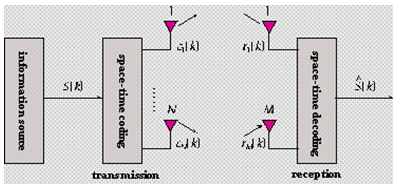
Fig. 1 Principle of MIMO System
In particular, the N sub-streams are simultaneously transmitted to the channels, and all the transmission signals occupy the same frequency band, so the bandwidth is not increased. If the channels between respective transmitting and receiving antennas respond independently, the MIMO system can create a plurality of parallel spatial channels. If information is independently transmitted via these parallel spatial channels, data rate can be increased.
MIMO treats the multi-path wireless channel and the transmission/reception as an integral system to make an improvement and thereby realize enhanced communication capacity and high spectrum efficiency. This type of temporal and spatial diversity and interference cancellation processing is almost optimal.
System capacity is one of the most important indicators for the communication system and represents the maximum transmission rate of the communication system. For an MIMO system in which the number of transmitting antennas is N and the number of receiving antennas is M, if the channels are independent Rayleigh fading channels and if N, M are very large, the channel capacity C is approximate to C=[min(M,N)]Blog2(ρ/2).
In the above formula, B is signal bandwidth, ρ is an average signal-to-noise ratio of the receiving end, and min(M,N) is the smaller of M, N. The above formula shows that when the power and the bandwidth are fixed, the maximum capacity or the upper limit of the capacity of the MIMO system increases with the increase of the minimum number of antennas. In contrast, under the same condition, the capacity of an ordinary intelligent antenna system that adopts multiple antennas or antenna arrays at the receiving end or the transmitting end only increases with the increase of the number of pairs of the antennas. The MIMO has a relatively large potential for increasing the capacity of wireless communication systems.
Apparently, at this time, channel capacity linearly increases with the increase of the number of antennas. In other words, it is possible to use MIMO channels to double the capacity of wireless channels, and to double the spectrum efficiency without increasing the bandwidth and the antenna transmission power. The use of MIMO technology can not only increase channel capacity but also improve the reliability of the channels and reduce the bit error rate.
At present, another popular research topic in the MIMO technical field is space-time coding. The common space-time codes include space-time block codes and space-time trellis codes. The main idea of space-time coding is to use spatial and temporal coding to realize space diversity and time diversity so as to reduce the bit error rate of the channels.
II. Analysis of the Situation of Patent Applications for MIMO Technology in China
1. Analysis of the Change of the Number of Patent Applications for MIMO Technology in China
Statistics show that China’s patent databases have included a total of 3332 patent applications for MIMO technology by September 5, 2012. Fig. 2 shows the number of the patent applications per year, and Fig. 3 shows a curve indicating the change of the number of applications. Please be noted that most of the patent applications have a period of 18 months from the filing date to the publication date. Therefore, it is only possible to obtain the accurate data on the applications filed before March, 2011. Thus, Figs. 2-3 only provide data to 2010, instead of data in 2011-2012.
The first patent application for MIMO technology in China was filed in 1992. The time period from 1992 to the present can be divided into two development phases. The first phase is a starting period from 1992 to 2002, with the number of applications being small and typically less than 10. The second phase is a fast development period from 2002 to the present, which shows a drastic increase in the number of patent applications at a high annual increase. From 35 in 2002 to 568 in 2010, the number of applications has increased by nearly 20 times in just 8 years. Although MIMO technology is only one of a large number of key technologies in the mobile communication field, the number of patent applications for this technology reaches more than 500 per year, so we can see that this technology is now very popular.

Fig. 2

Fig. 3
2. Analysis of Regional Distribution of Patent Applicants for MIMO Technology in China
This section will analyze the regional distribution of patent applicants for MIMO technology in China. First of all, these applications are divided into foreign applications and domestic applications depending on whether the applicants are foreign entities/individuals or Chinese entities/individuals, and the proportions of these two kinds of applications are listed. Then the number of foreign applications from each country is listed.
2.1 Proportions of Foreign Applications and Domestic Applications
Fig. 4 shows the proportions of foreign applications and domestic applications to the total number of applications, wherein the total number of foreign applications is 1470 and accounts for 44%, while the total number of domestic applications is 1862 and accounts for 56%. Although the total number of domestic applications exceeds the total number of foreign applications by 12%, please note that the domestic applicants also include the branches of foreign companies in China, such as Shanghai Bell and Beijing Samsung Research Institute, whose patent applications actually belong to the foreign companies. Judging from a qualitative perspective, the total number of foreign applications and the total number of domestic applications are approximately equal to each other.
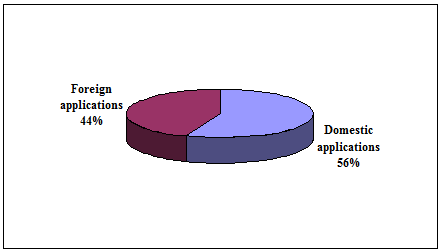
Fig. 4
2.2 Regional Distribution of Foreign Applications
Fig. 5 shows the proportion of the number of applications from each country or region. As shown in Fig. 5, the applications with applicants from the U.S., Japan and South Korea account for most of the foreign applications, and their proportions are respectively 36.05%, 28.84% and 16.05%, all together 80.94% in total. The proportions of the number of applications with applicants from other countries are very small and do not exceed 5%. However, if all the European countries are treated as a whole (including Italy, Great Britain, France, Germany, Sweden, Netherlands, Israel, etc.), the number of applications from these countries account for 15.37%.
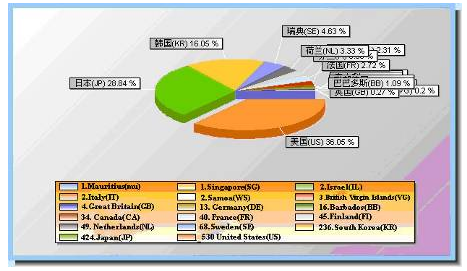
Fig. 5
Fig. 6 lists the countries whose numbers of applications are among the top 10. The U.S. ranks the first with 530 applications. The second is Japan with 424 applications. South Korea has a smaller number of applications than Japan, that is, 236.
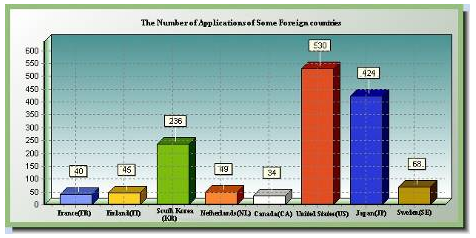
Fig. 6
3. Analysis of Main Applicants of Patent Applications for MIMO Technology in China
The above analysis of the regional distribution of patent applications for MIMO technology in China may be valuable for governmental departments to formulate patent policies. However, companies or individuals may put more focus on the main applicants in this field, because these applicants play a vital role in the research and development of this field and may be main competitors or partners of other applicants. This section will analyze the main applicants in this field from the number of applications and the number of patents.
3.1 Analysis of Applicants based on the Number of Applications
Fig. 7 lists the applicants whose numbers of applications for MIMO technology in China are among the top 10. ZTE Corporation ranks first with 451 applications, which is more than Huawei Technologies Corporation, which ranks second, by 80%. Qualcomm Inc. from the US ranks third with a slightly smaller number of applications than Huawei. Panasonic Corporation ranks fourth, with a notable drop in number as compared with Qualcomm. Among the top 10 applicants, there are 4 Chinese applicants, 2 US companies, 2 Japanese companies and 2 Korean Companies.
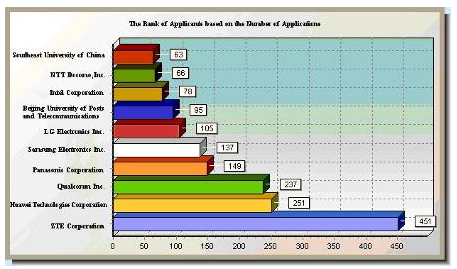
Fig. 7
Fig. 8 separately shows the rank of domestic applicants. Besides ZTE, Huawei and Datang, there are also branches of two foreign companies in China, i.e., Shanghai Bell and Beijing Samsung. The other 5 applicants are domestic universities.
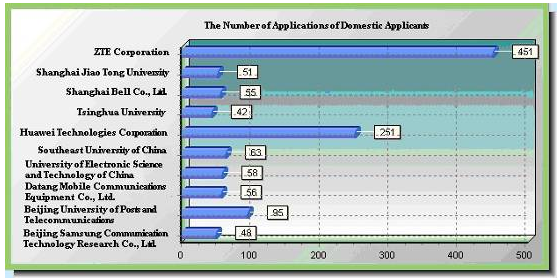
Fig. 8
3.2 Analysis of Applicants based on the Number of Patents
The number of applications alone cannot completely reflect the status of the applicant in this field. The number of granted patents can better reflect the status. Fig. 9 shows the top 10 applicants ranked based on the number of patents. Firstly, the rank of the first 3 applicants is not changed, i.e., ZTE, Huawei and Qualcomm. However, although the number of applications of ZTE is larger than Huawei by 80%, the number of patents of ZTE is higher than Huawei only by 17%. The number of applications of Qualcomm is less than Huawei only by 5%, but the number of patents of Qualcomm is less than Huawei by 26%. Secondly, Panasonic Corporation, which ranks fourth in the number of applications, has only 23 patents and drops to No. 9 in the number of patents. Samsung replaces Panasonic to rank fourth in the number of patents. Thirdly, LG Electronics, Intel, NTT and Southeast University of China, which are among the top 10 in the number of applications, do not enter the top 10 in the number of granted patents. Instead, Shenzhen Kuang-Chi Institute of Advanced Technology, US Broadcom Corporation, Shanghai Jiao Tong University and Tsinghua University appear among the top 10 in the number of patents. To summarize, among the top 10 applicants in the number of patents, there are 6 Chinese applicants, 2 US companies, 1 Korean company and 1 Japanese company.
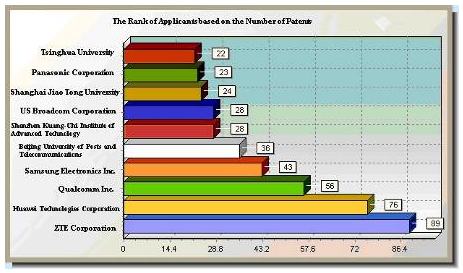
Fig. 9
4. Analysis of Technical Themes of Patent Applications for MIMO Technology in China
The purpose of this section is to analyze the technical themes of patent applications for MIMO technology in China. Since China’s patent databases only uses the classification system of IPC instead of ECLA, ICO or FI/F-TERM, which is more specific, our analysis of the technical themes based on IPC is merely an approximation.
Fig. 10 shows the number of applications per year in the unit of IPC codes and provides the top 8 frequently applied IPC codes. First of all, the following is an explanation of the meaning of these IPC codes:
H04L1/06: Arrangements for detecting or preventing errors in the information received by space diversity reception
H04B7/06: Diversity systems using a plurality of spaced independent aerials at transmitting station
H04B7/04: Diversity systems using a plurality of spaced independent aerials
H04L27/26: Modulated-carrier systems using multi-frequency codes
H04L1/00: Arrangements for detecting or preventing errors in the information received
H04B7/08: Diversity systems using a plurality of spaced independent aerials at receiving station
H04B7/02: Radio transmission systems using diversity systems
H04L25/02: Baseband systems details/components
Apparently, patent applications in the MIMO technical field are concentrated on the groups of H04L1/00 and H04B7/00. Technically speaking, these two groups are slightly different. The theme of H04L1/00 is how to prevent the error of the diversity receiving system at the receiving end and primarily relates to the data link layer technology, such as modulation and demodulation, encoding and decoding. The theme of H04B7/00 is radio transmission system with multiple antennas and mainly relates to the physical layer technology, such as power control, directionality of multiple antennas, and polarization of multiple antennas.
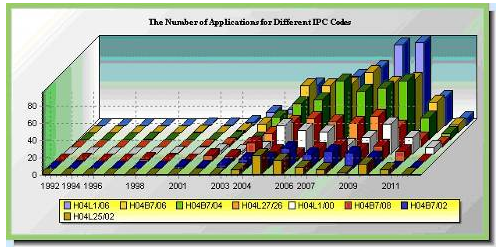
Fig. 10
In order to more clearly exhibit the change of patent applications for the two groups H04L1/00 and H04B7/00, Fig. 11 only shows the annual number of applications for these two groups without involving other classification codes. As shown in Fig. 11, the number of applications for H04B7/00 increases rapidly from 2002 to 2008 and is obviously larger than H04L1/00. This indicates that the number of applications relating to the physical layer during this period are much higher than the applications relating to the data link layer. However, from 2008, the number of applications for H04B7/00 slightly decreases, whereas the number of applications for H04L1/00 largely increases and is close to that of H04B7/00 in 2010. This indicates that in recent years, research on the physical layer technology has slightly decreased while research on the data link layer technology keeps increasing.

Fig. 11
III. Prediction of the Prospect of MIMO Technology
Through the statistics and analysis of patent applications for MIMO technology in China in Chapter 2, we can accurately identify the status quo of patent applications for MIMO technology in China. By reasonably analyzing and predicting the trend of all the current data, we can roughly predict the prospect of this technology in the near future.
As can be reasonably foreseen from the change in the number of applications in section 2.1, in the near future, the number of patent applications for MIMO technology in China will remain fast developing, and the annual number of applications will remain large and probably increase year by year.
The main applicants for MIMO technology in China may not change largely. The Chinese applicants are still represented by ZTE and Huawei, the US applicants are still represented by Qualcomm, the Japanese applicants are still represented by Panasonic, and the Korean applicants are still represented by Samsung.
The technical field of the applications may still focus on the two groups H04L1/00 and H04B7/00, and in the next few years, the number of applications for H04L1/00 will probably exceed the number of applications for H04B7/00.











